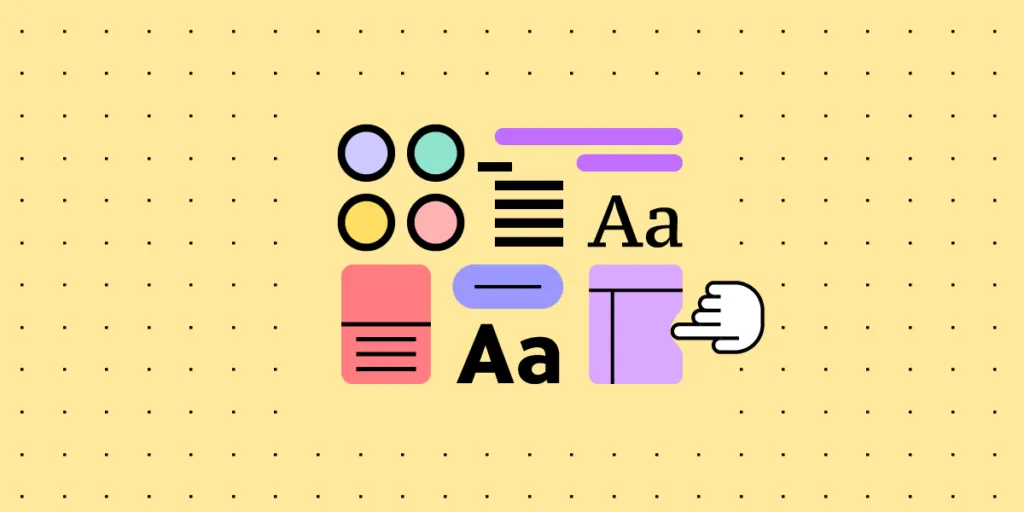What is Design System Testing? Definition, Benefits, and Process

Testing is vital for ensuring your design system provides the tools, guidance, components, and support teams need to deliver high-quality products efficiently. Design system testing assesses every aspect of the component library, documentation, syntax, accessibility, and more to ensure it meets the organization’s standards and expectations.
This article explores design system testing, when to test, roles and responsibilities, procedures, and tools teams use to conduct various tests.
Create a single source of truth, reduce operation burdens, and minimize errors with a code-to-design design system workflow from UXPin Merge. Visit our Merge page for more details and how to request access.
Table of Contents
What is Design System Testing?
Design system testing (design system auditing) evaluates a design system’s functionality, usability, documentation, quality, and consistency. This evaluation aims to ensure the design system meets the requirements and expectations of its users and stakeholders.
A typical design system testing process might include:
- Component testing: Evaluate individual components for visual consistency and function as expected.
- Pattern testing: Ensure patterns are applied consistently across user interfaces and use cases.
- Design file testing: Comparing design files to repository components to ensure designers and engineers share the same UI elements and patterns.
- Accessibility testing: Validate that components, patterns, and templates meet design system accessibility standards and guidelines.
- Cross-platform and cross-browser testing: Ensure the design system and components works consistently across different devices, platforms, operating systems, and browsers.
- Performance testing: Measure the design system’s impact on overall product performance, including load times and responsiveness.
- Usability testing: Analyze user research and conduct interviews to ensure the design system supports a positive user experience.
- Documentation testing: Review design system documentation, including its guidelines (brand, content, code, design, etc.), to ensure it’s comprehensive and provides adequate user support.
Why is Design System Testing Important?
Design system testing is vital for the integrity of the UI library and the products it serves. Errors and inconsistencies left unchecked can quickly compound into bigger issues for product teams and end-users.
A design system’s primary purpose is to serve as a single source of truth. When a design system is compromised, it no longer serves as a trustworthy source for product consistency and coherence.
How Often Should You Test a Design System?

The frequency of design system testing will depend on multiple factors:
- The size and complexity of the design system
- Design system maturity
- Available resources (labor, time, financial)
- Product ecosystem
- Frequency of updates
Here are some scenarios and intervals organizations might consider testing a design system.
Regular interval testing
The design system team may create a schedule for regular testing, such as monthly, quarterly, bi-annually, etc. A fixed testing program allows the DS team to plan while managing stakeholder and user expectations.
After significant updates or additions
It’s common for design system teams to audit a design system after a major update or when introducing new components, patterns, or guidelines. This audit ensures the changes function as expected while maintaining high UI consistency and coherence standards.
Addressing usability, accessibility, and performance issues
When product teams identify usability, accessibility, or performance issues, it’s crucial to audit the entire design system. This audit will evaluate the depth of the problem and appropriate corrective action.
It’s important to note that waiting for problems to emerge is not a good strategy for testing a design system. Adopting a more proactive approach, like regular interval testing or post updates, is better for catching and correcting issues early.
Agile development
Organizations that follow agile development practices may incorporate regular testing into the development process. This agile approach would mean tests occur more frequently, possibly integrated into sprints or release cycles.
Who is Responsible for a Design System Audit?

A comprehensive design system audit requires a cross-functional team with different expertise. In contrast, smaller or more specific tests may only need one or two specialists.
Depending on the scale and scope, here is a list of team members you might consider for your design system test. Keep in mind that companies may have one team member performing multiple functions listed below. For example, a UX designer may assess design, accessibility, and content, while an engineer covers UI components and QA.
- UX/UI designers: assess visual consistency, usability, and overall user experience of the components and patterns. They also check design-specific documentation, tools, and UI kits.
- Developers: Front-end and back-end developers evaluate component functionality, syntax, performance, and implementation. They also test the UI library across platforms and browsers.
- Accessibility specialists: These team members have up-to-date expertise in accessibility standards and guidelines. They test the design system to organizational and regional accessibility requirements.
- QA engineers: Quality assurance (QA) engineers create and execute tests in accordance with the design system’s quality standards.
- Product managers or project managers: Many companies treat testing like a project requiring a team member to coordinate and oversee the process, including establishing timelines, allocating resources, and ensuring the team aligns on objectives and priorities. They may also gather findings to produce a final report, including the next steps.
- Content designers or copywriters: Review design system documentation, content guidelines, messaging, tone, voice, etc., for consistency and accuracy across components and patterns.
Design System Testing Workflow

Here are some suggested steps for executing a design system audit.
- Define objectives: Establish the goals and objectives of the design system test. i.e., identifying inconsistencies, evaluating accessibility, or assessing performance.
- Develop a plan: A test plan outlines the audit’s scope, methods, resources, schedule, and success criteria. An effective test plan must guide testing, assigns roles, and keep team members aligned.
- Identify test cases and scenarios: Determine the specific test cases and scenarios team members must use to evaluate various parts of the design system. These must be consistent for every test to ensure you can measure KPIs and performance over time.
- Prepare tools and resources: Gather the tools and resources team members need to complete their work, including testing frameworks, accessibility checkers, performance analyzers, usability testing methods, etc.
- Execute tests: Conduct tests according to the plan, documenting the results and issues.
- Analyze test results: Review tests to identify patterns, trends, or areas of concern. Determine issue severity, prioritize fixes, and add to UX or tech backlogs.
- Report findings and recommendations: Prepare a comprehensive report for design system users and stakeholders with test outcomes, findings, and recommendations.
- Fix issues and implement improvements: The design system team must implement changes according to the report updating components, patterns, guidelines, and documentation as needed.
- Monitor, re-test, and iterate: Test releases to ensure they solve issues appropriately. Monitor changes to assess effectiveness, testing and iterating until you achieve the desired outcome.
Tools for Design System Testing

There are many tools available for testing different aspects of a design system. Here are a few categories and examples.
Visual consistency testing
- Percy: A visual testing tool that helps detect visual changes and inconsistencies across components and layouts.
- Chromatic: Automates gathering UI feedback, visual testing, and documentation–created by Storybook for built-in tests.
- SauceLabs Sauce Visual Testing: Find and fix visual errors and inconsistencies across all browsers and resolutions early in the development lifecycle.
Functionality and integration testing
- Jest: A JavaScript testing framework that supports component and integration testing for JavaScript libraries and frameworks, including React, Vue, and Angular.
- Cypress: An end-to-end testing tool for testing browser-based web applications.
Accessibility testing
- axe: An accessibility testing tool for identifying and resolving accessibility issues in web applications.
- Lighthouse: An open-source tool from Google that provides automated auditing for accessibility, performance, and other best practices.
- WAVE: A web accessibility evaluation tool that helps identify and resolve accessibility issues.
- UXPin: Built-in color contrast checker and color blindness simulators allow designers to test UIs on the fly.
Cross-platform and cross-browser testing
- BrowserStack: A platform providing access to various browsers and devices for testing web applications across different environments.
- Sauce Labs: A cloud-based platform for automated and manual testing across browsers, platforms, and devices.
Performance testing
- WebPageTest: An open-source tool for measuring web page performance, including load times, rendering speed, and optimization recommendations.
- Google PageSpeed Insights: A free tool that analyzes web page performance and provides suggestions for improvement.
- Digital.ai Continuous Testing: Continuously test functional, performance, and accessibility scenarios on a matrix of devices and browsers with various manufacturers operating systems.
Usability testing
- UserTesting: A platform for conducting remote usability tests with real users, capturing their feedback and interactions.
- Ethnio: A research ops platform for recruiting participants who use your products and features using intercepts. Helpful for getting feedback from users who interact with specific components or patterns.
- Optimal Workshop: A suite of usability testing tools, including card sorting, tree testing, and first-click testing.
- UXPin Merge: A tool for building prototypes using components from your design system for accurate high-fidelity usability testing.
Design system documentation and collaboration
- Storybook: An open-source tool for building and organizing UI components, making design system testing collaborative and accessible. Storybook integrates with UXPin to bridge the gap between design and development.
- UXPin Design Systems: A tool for building, managing, and scaling design systems with shared documentation, assets, and style guide.
A Single Source of Truth With UXPin Merge
Maintenance and governance are the biggest design system challenges, especially when there is no single source of truth between design and development.
UXPin Merge bridges the gap between design and development by syncing your design system’s repository with UXPin’s design editor so design and engineering teams use the same component library–creating a true single source of truth across the organization.
Learn more about UXPin Merge’s code to design workflow and how it benefits design systems, including better maintenance, collaboration, and governance. Visit our Merge page for more details.




